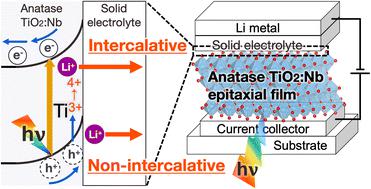当前位置:
X-MOL 学术
›
Sustain. Energy Fuels
›
论文详情
Our official English website, www.x-mol.net, welcomes your feedback! (Note: you will need to create a separate account there.)
Intercalative and non-intercalative photo-recharge using all-solid-state cells for solar energy conversion and storage
Sustainable Energy & Fuels ( IF 5.6 ) Pub Date : 2024-02-14 , DOI: 10.1039/d3se01636f Masataka Yoshimoto 1 , Kazuhisa Tamura 2 , Kenta Watanabe 1 , Keisuke Shimizu 3 , Yuhei Horisawa 1 , Takeshi Kobayashi 4 , Hanae Tsurita 4 , Kota Suzuki 3 , Ryoji Kanno 3 , Masaaki Hirayama 1, 3
Sustainable Energy & Fuels ( IF 5.6 ) Pub Date : 2024-02-14 , DOI: 10.1039/d3se01636f Masataka Yoshimoto 1 , Kazuhisa Tamura 2 , Kenta Watanabe 1 , Keisuke Shimizu 3 , Yuhei Horisawa 1 , Takeshi Kobayashi 4 , Hanae Tsurita 4 , Kota Suzuki 3 , Ryoji Kanno 3 , Masaaki Hirayama 1, 3
Affiliation

|
Photo-rechargeable systems, which can efficiently convert and store solar energy into chemical energy within single devices, are essential to harness sunlight effectively. Photo-(de)intercalation plays a pivotal role in the functionality of photo-rechargeable systems. Nevertheless, the photo-(de)intercalation process has not been conclusively confirmed owing to potential interference from side reactions, such as the decomposition of liquid electrolytes and the elution of electrode materials. In this study, we successfully demonstrated photo-responsive Li+-deintercalation using an all-solid-state thin-film battery composed of epitaxially grown anatase TiO2 doped with Nb (a-TiO2:Nb) as the cathode, in combination with operando X-ray diffractometry. Under light irradiation, Li+-deintercalation occurred and was subsequently reversibly intercalated into a-TiO2:Nb during discharge. Furthermore, it was observed that a portion of the charge capacity under light irradiation resulted from non-intercalative (non-redox-reactive) electron transfer, akin to supercapacitors. These findings suggest that both intercalative and non-intercalative photo-charging mechanisms can be applied to secondary batteries and supercapacitors, respectively. Therefore, photo-rechargeable all-solid-state cells, encompassing both secondary batteries and supercapacitors, hold significant promise for advancing solar energy conversion and storage.
中文翻译:

使用全固态电池进行插层和非插层光充电以进行太阳能转换和存储
光充电系统可以在单个设备内有效地将太阳能转化并存储为化学能,对于有效利用阳光至关重要。光(脱)嵌入在光充电系统的功能中起着关键作用。然而,由于副反应(例如液体电解质的分解和电极材料的洗脱)的潜在干扰,光(脱)嵌入过程尚未得到最终证实。在这项研究中,我们成功地证明了光响应Li +脱嵌,使用由外延生长的掺杂Nb的锐钛矿TiO 2 (a-TiO 2 :Nb)组成的全固态薄膜电池作为阴极,结合操作X 射线衍射法。在光照射下,Li +发生脱嵌,随后在放电过程中可逆地嵌入到a-TiO 2 :Nb 中。此外,还观察到光照射下的部分充电容量是由非嵌入(非氧化还原反应)电子转移产生的,类似于超级电容器。这些发现表明,嵌入和非嵌入光充电机制都可以分别应用于二次电池和超级电容器。因此,包括二次电池和超级电容器在内的光可充电全固态电池对于推进太阳能转换和存储具有重大前景。
更新日期:2024-02-14
中文翻译:

使用全固态电池进行插层和非插层光充电以进行太阳能转换和存储
光充电系统可以在单个设备内有效地将太阳能转化并存储为化学能,对于有效利用阳光至关重要。光(脱)嵌入在光充电系统的功能中起着关键作用。然而,由于副反应(例如液体电解质的分解和电极材料的洗脱)的潜在干扰,光(脱)嵌入过程尚未得到最终证实。在这项研究中,我们成功地证明了光响应Li +脱嵌,使用由外延生长的掺杂Nb的锐钛矿TiO 2 (a-TiO 2 :Nb)组成的全固态薄膜电池作为阴极,结合操作X 射线衍射法。在光照射下,Li +发生脱嵌,随后在放电过程中可逆地嵌入到a-TiO 2 :Nb 中。此外,还观察到光照射下的部分充电容量是由非嵌入(非氧化还原反应)电子转移产生的,类似于超级电容器。这些发现表明,嵌入和非嵌入光充电机制都可以分别应用于二次电池和超级电容器。因此,包括二次电池和超级电容器在内的光可充电全固态电池对于推进太阳能转换和存储具有重大前景。



























 京公网安备 11010802027423号
京公网安备 11010802027423号